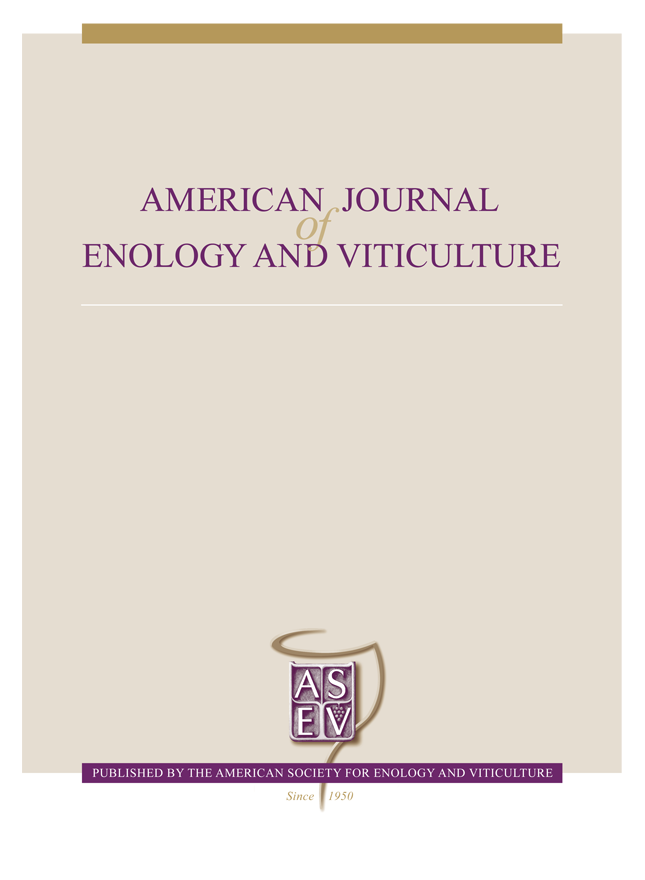Journal article published in American Journal of Enology and Viticulture, volume 73, pp. 293–306.
Authors: .
Abstract
Consumer demand for wines free of, or with, reduced levels of preservatives provide new challenges for innovation in winemaking. The addition of microorganisms as bioprotective agents to avoid or reduce sulfur dioxide (SO₂) addition during winemaking is a possible intervention strategy that could be of interest to winemakers. A strain of Pichia kluyveri and one of Lactiplantibacillus plantarum were inoculated into a Nebbiolo red grape must, previously inoculated with a mix of microorganisms to mimic a grape must environment. The synergistic effect of the added strains with no, low (1 g/hL), or moderate (3 g/hL) addition of total SO₂ was explored over two vintages (2019 and 2020). Wine fermentations were monitored for microbiological (yeast and lactic and acetic acid bacterial populations) and physicochemical attributes (standard chemical parameters, chromatic characteristics, phenolic and aroma compounds). Microbiological analyses showed fewer undesired microorganisms, namely Acetobacter aceti and Hanseniaspora uvarum, independently from the strain used; this decrease occurred faster when starter cultures were combined with SO₂. Chemical analyses revealed less acetic acid and ethyl acetate in the bioprotected wines. The bioprotective ability of the starter cultures occurred in both vintages. This study examines P. kluyveri and L. plantarum as bioprotective agents in winemaking to reduce SO₂ additions during the first steps of wine production.
Key words bioprotection, fermentation dynamics, Lactiplantibacillus plantarum, Pichia kluyveri, sulfur dioxide, wine composition
BibTeX entry: click to show
@article{
2318_1876729,
url = {https://hdl.handle.net/2318/1876729},
author = {Englezos, Vasileios and Di Gianvito, Paola and Peyer, Lorenzo and Giacosa, Simone and Río Segade, Susana and Edwards, Nathalia and Rolle, Luca and Rantsiou, Kalliopi and Cocolin, Luca},
title = {Bioprotective effect of Pichia kluyveri and Lactiplantibacillus plantarum in winemaking conditions},
year = {2022},
journal = {American Journal of Enology and Viticulture},
volume = {73},
abstract = {Consumer demand for wines free of, or with, reduced levels of preservatives provide new challenges for innovation in winemaking. The addition of microorganisms as bioprotective agents to avoid or reduce sulfur dioxide (SO₂) addition during winemaking is a possible intervention strategy that could be of interest to winemakers. A strain of Pichia kluyveri and one of Lactiplantibacillus plantarum were inoculated into a Nebbiolo red grape must, previously inoculated with a mix of microorganisms to mimic a grape must environment. The synergistic effect of the added strains with no, low (1 g/hL), or moderate (3 g/hL) addition of total SO₂ was explored over two vintages (2019 and 2020). Wine fermentations were monitored for microbiological (yeast and lactic and acetic acid bacterial populations) and physicochemical attributes (standard chemical parameters, chromatic characteristics, phenolic and aroma compounds). Microbiological analyses showed fewer undesired microorganisms, namely Acetobacter aceti and Hanseniaspora uvarum, independently from the strain used; this decrease occurred faster when starter cultures were combined with SO₂. Chemical analyses revealed less acetic acid and ethyl acetate in the bioprotected wines. The bioprotective ability of the starter cultures occurred in both vintages. This study examines P. kluyveri and L. plantarum as bioprotective agents in winemaking to reduce SO₂ additions during the first steps of wine production.},
keywords = {bioprotection, fermentation dynamics, Lactiplantibacillus plantarum, Pichia kluyveri, sulfur dioxide, wine composition},
doi = {10.5344/ajev.2022.22008},
pages = {293--306}
}
Publication availability
Accepted manuscript
This file is available in an accepted manuscript version from the IRIS institutional repository.
This file is subjected to usage limitations according to its license.
View or request this publication
You can find the postprint version of this article in the Open Access Repository of the University of Torino:
IRIS-AperTO record 2318/1876729
View the final version at publisher:
doi:10.5344/ajev.2022.22008
File not available? Do you need further information?
You can contact me and request this article through the following form:
